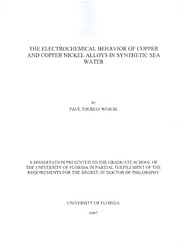
Electrochemical behavior of copper and copper nickel alloys in synthetic sea water PDF
Preview Electrochemical behavior of copper and copper nickel alloys in synthetic sea water
THEELECTROCHEMICALBEHAVIOROFCOPPER ANDCOPPERNICKELALLOYSINSYNTHETICSEA WATER By PAULTHOMASWOJCIK ADISSERTATIONPRESENTEDTOTHEGRADUATESCHOOLOF THEUNIVERSITYOFFLORIDAINPARTIALFULFILLMENTOFTHE REQUIREMENTSFORTHEDEGREEOFDOCTOROFPHILOSOPHY UNIVERSITYOFFLORIDA 1997 ACKNOWLEDGMENTS Theauthorwishestoexpresshisgratitudetokeyindividualsfortheircontribution tothisdissertationandtotheenhancementofthislearningexperience.Hewouldliketo thankDr.MarkE.Orazemforhisguidance,supportandinsightfulsuggestions.The authorwouldalsoliketothankmembers,bothpastandpresent,oftheElectrochemical EngineeringGroupattheUniversityofFloridafortheirstimulatingargumentsand informativediscussions.OliverMoghissiandSteveCarsonhavebeenagreathelpon topics ofelectrochemistry, and Pankaj Agarwal and Doug Reimer have been indispensableintheareasofmeasurementmodelsandcomputersrespectively.His motherandfatherreceiveaspecialthankyouforsupplyingtheadvice,supportofhis decisions, andencouragementwhich hasmadethis educational experiencetruly enjoyable. TABLEOFCONTENTS page ACKNOWLEDGMENTS ii LISTOFTABLES vi LISTOFFIGURES vii LISTOFSYMBOLS xiv ABSTRACT xvi CHAPTER1INTRODUCTION 1 CHAPTER2 BACKGROUND 6 2.1CopperUtilityinSeaWaterEnvironments 6 2.2ModelLimitations 7 2.2.1Limitationsofthermodynamicinformation 7 2.2.2Realsystemchemicalcharacterizationinadequacies 8 2.2.3Under-predictedreactionrates 8 2.2.4Chemicalreactiontimes 8 2.3Thermodynamics 8 2.4CorrosioninAlkalineChlorideSolutions 18 2.5CopperinSeaWaterEnvironments 20 2.6ElectrochemicalBehaviorofCopperinAqueousEnvironmentswith Flow 24 2.6.1Erosioncorrosion 24 2.6.2Causesandindications 25 CHAPTER3 ELECTROCHEMICALTECHNIQUES 28 1 1 3. LargeSignalAmplitudeMeasurementTechniques 29 3.2SmallSignalAmplitudeMeasurementTechniques 29 3.3ElectrochemicalImpedanceSpectroscopy 30 CHAPTER4EXPERIMENTALMETHOD 36 4.1ImpingingJetSystem 36 4.2SampleandSolutionPreparation 42 4.3ExperimentalProcedure 43 CHAPTER5VMAORDIUALBALETEADMPILMIPTEUDDAENCGEALSVPAENCOTSRTOASTCIOCPAYLLY 48 5.1Variable-AmplitudeGalvanostaticModulationAlgorithm 55 5.2PredictionoftheAmplitudeoftheCurrentPerturbation 56 5.3PredictionoftheValuefortheCurrentMeasuringResistor 58 5.4ApplicationtoCorrosionMeasurements 62 5.5ComparisonWithOtherTechniques 64 5.6ExperimentalStudies 71 CHAPTER6RESULTSANDDISCUSSION 76 6.1TheMeasurementModelApproach 78 6.2LinearSweepVoltammetry 79 6.3CopperinPartially-AeratedElectrolyte:Part1 87 6.4CopperinPartially-AeratedElectrolyte:Part2 105 6.570/30Copper/NickelAlloyinAeratedElectrolyte 11 6.6CopperinAeratedElectrolyte 117 6.7X-rayPhotoelectronSpectroscopyAnalysis 128 6.8CopperRodsinSyntheticSeaWater 136 CHAPTER7COMPARISONWITHPASTRESULTS 147 CHAPTER8CONCLUSIONS 155 CHAPTER9SUGGESTIONSFORFUTUREWORK 158 APPENDICES A:ELECTROCHEMISTRY 161 B:TIMESUMMARIES 165 REFERENCES 171 BIOGRAPHICALSKETCH 178 LISTOFTABLES page Tabler2e.f1:erSeenlceecdtetodastnaonrdmaardlehlyedcrtorgodeenpeolteecnttrioadles(inBaarqdue&ouFsausloklnuteiron1s98a0t)2.5°C 9 Table2.2:Cathodicreactionsforcopperinanalkalineaqueoussolution. 19 Table2.3:ElementalcompositionofASTMD-l141-52formulaAsyntheticsea 21 water. Table2.4:Coppercompoundspossibleinacopper/syntheticseawatersystem. 22 Thecolorandsolubilityinwateraregivenforeachcompound(Weast 1984). Tablea2n.5d:hHyedtreorxoigdeenceaorubsoneaqutielsib(rSiatuimnvmol&viMnogrogxaidnes1,98h1yd).roxides,carbonates, 23 Table5.1:CurrentmeasuringresistorrangesforaPAR273potentiostat. 61 Tableb5e.2:viPsauarlaimzeetderbyvailnuseesrtfioorneolfecRtraicnadlCcirvcauliutess1inatnodF2i.guCirrecu5i.5t.s1and2can 65 Table6.1:Timelinehighlightingmajoreventsfortheexperimentpresentedin 92 Figures6.5-6.16. TableW7.a1t:erCr(iEtfiicradl,V1e9l7o7c)i.tyandShearStressforCopper-BasedAlloysinSea 150 TableBl:SummaryofexperimentaleventsfordatapresentedinSection6.3. 166 TableBlcont. 167 TableB2:SummaryofexperimentaleventsfordatapresentedinSection6.4. 168 TableB3:SummaryofexperimentaleventsfordatapresentedinSection6.5. 169 TableB4:SummaryofexperimentaleventsfordatapresentedinSection6.6. 170 5 LISTOFFIGURES Page Figure252.°C1:.PSootleindtisaulb-sptHanecqeusiluinbdreirumcodnisaigdrearamtfioornaarceopCpue,rC/uw2a0t,eransdysCtueOm.atThe 12 nEluemcbterroschienmtihciaslfEiqguuirleicborirareisnpAoqnduetoourseaScotliuotnisongsi.veAnminortheedAettlaaisleodf descriptionofthisfigureisgiveninthereference(Pourbaix1974). Figure2.2:Potential-pHequilibriumdiagramforacopper/watersystemat 13 25°C.SolidsubstancesunderconsiderationareCu,Cu20,andCu(OH)2 (Pourbaix1974).Thenumbersinthisfigurecorrespondtoreactionsgiven intheAtlasofElectrochemicalEquilibriainAqueousSolutions.Amore detaileddescriptionofthisfigureisgiveninthereference(Pourbaix 1974). Figure2.3:Potential-pHequilibriumdiagramforacopper/seawatersystemat 14 25°C.SolidsubstancesunderconsiderationareCu,Cu20,CuCl,CuO,and tChue2r(eOfHe)r3enCcle.wThhiechnugmivbeesrsadinettahiilsedfidgeusrcercipotriroenspoofntdhitsofriegaucrteio(nBsiagnicvhein&in Longhi1973). Figure252.°4C:.PSootleindtisaulb-sptHanecqeusiluinbdreirumcodnisaigdrearamtfioornaarceopCpue,rC/us2e0a,waCtueCrl,systemat 1 Cu(OH)2,andCu2(OH)3Cl.Thenumbersinthisfigurecorrespondto rfeiagucrteio(nBsigaincvhein&intLhoengrhefier1e9n7c3e).whichgivesadetaileddescriptionofthis Figure2.5:Potential-pHequilibriumdiagramforacopper/seawatersystemat 16 25°C.SolidsubstancesunderconsiderationareCu,Cu20,CuO,CuCl,and CuC03-Cu(OH)2.Thenumbersinthisfigurecorrespondtoreactions g(Biivaenncihnit&heLroenfgehreinc1e97w3h)i.chgivesadetaileddescriptionofthisfigure 7 Figure2.6:Potential-pHequilibriumdiagramforacopper/seawatersystemat 1 25°C.SolidsubstancesunderconsiderationareCu,Cu20,CuCl, Cu(OH)2,andCuC03Cu(OH)2.Thenumbersinthisfigurecorrespondto rFeiagcutrieon(sBigainvcehnii&ntLhoenrgehfier1e9n7c3e)w.hichgivesadetaileddescriptionofthis Figure3.1:Current/Potentialcurvestodemonstratelinearresponsefromsmall 35 signalperturbation(Gabrielli,1980). Figurec4o.n1d:ucStheedarhesrtree.ssThaesadifmuenncstiioonnloefssjetquvaenltoictiytyr/frorretphreeesxenptesritmheenrtaatliowoofrkthe 38 radialposition/electroderadius. Figure4.2:Experimentalconfigurationusedforinvestigatingtheinfluenceofjet 46 velocityonthecorrosionofcopperandcopperalloysinsyntheticsea water. Figure4.3:Schematicillustrationoftheimpingingjetcellandimportantcell 47 components. Figureex5.p1er:iSmcehnetmaotnicthiellcuosrtrroatsiioonnopfottehnetiianlfloufenacseyosfteampowtietnhtiaoscthaatincgiinmgpedance 53 baseline. Figure5.2:Sequentialcurrentpotentialcurvesforasystemwithatransient 54 corrosionpotential. Figure5.3:Potentialperturbationfortestcircuit,Circuit1,resultingfrom 55 traditionalgalvanostaticimpedancemeasurementsusingfixedamplitude currentperturbations. Figureme5.t4h:oCdosmfpoarrtihseovnarbieatbwleeeanmptlheitoundeepaolignotriatnhdmtwhirtehepaoi1n0tmprVedtiacrtgieotn 58 potentialperturbation. Figure5.5:Testcircuitandconnections. 64 Figurega5l.v7:anIosmtpaetdiac,ncVeApGl,anaenpdloptotfeonrtitoessttactiirccutietcChenlilque1sc.omparingconventional 67 Figure5.8:Therealcomponentoftheimpedanceasafunctionoffrequencyfor 68 testcircuitCell1comparingconventionalgalvanostatic,VAG,and potentiostatictechniques. . Figure5.9:Theimaginarycomponentoftheimpedanceasafunctionof 68 VfrAeGq,uenacnydfpoortetnetsitocsitractuiicttCeeclhlni1qcueosm.paringconventionalgalvanostatic, Figure5.10:ImpedanceplaneplotfortestcircuitCell2comparingconventional 69 galvanostatic,VAG,andpotentiostatictechniques.Notetheorderof magnitudechangeintheimpedancevaluescomparedtoCell1 Figure5.11:Therealandimaginarycomponentsoftheimpedanceasafunction 70 offrequencyfortestcircuitCell2comparingconventionalgalvanostatic, VAG,andpotentiostatictechniques. FigureA5S.1T2:MI1m1p4e1dasnyncteheptliacnesepalowtatfeorr.9C9o.m9p%arpuirseoncobpeptewreeelnecVtAroGdeainmdmersedin 73 potentiostatictechniquessuggestthatsmallchangesinthesystem amdevaesrusreelmyeenftfsectcomnedauscutreedmienntthsemVaAdeGimnotdheepaorteenrteiporsotdautciicbmleo.dewhile Figure5.13:Impedanceplaneplotfor99.9%purecopperelectrodeimmersedin 74 ASTM1141syntheticseawater.Comparisonbetweenconventionalfixed amplitudegalvanostatic,VAG,andpotentiostatictechniques. Figure5.14:Therealcomponentoftheimpedanceasafunctionoffrequencyfor 75 dwaattaerprceosmepnatredinigncFoingvuernet5i.o1n3a.l9g9a.lv9a%nocsotpapteircainmdmeVrAseGdtiencshynnitqhueetsi.csea Figure5.15:Theimaginarycomponentoftheimpedanceasafunctionof 75 wfarteeqruecnocmyp(asreienFgigcuorneve5n.t1i3o)naflorg9al9v.a9n%osctaotpipceranidmmVeArsGedteicnhnsiyqnutehse.ticsea Figure6.1:Linearsweepvoltammogramatthreedifferentsweeprates.Applied 83 potentialversusresultingcurrent(Charriere1997). Figure6.2:Cyclicvoltammogramwitharateof66mV/s(Charriere1997). 83 Figure6.3:Potentialtimetracesfor99.9%purecopperinaeratedsyntheticsea 84 water.Velocity(=0.1m/s)maintainedatlowvalueprimarilytoensure uniformmasstransfertothesurfaceandremovalofcorrosionproducesnot tightlyadheredtothesurface. Figureco6n.4s:taPnrtog2r0e0s.s0iomnV.ofIamafiglemsgprroowgirnesgsdfurrionmglpefottetnotiriogshtta,titcotcalonetlraoplsaetdtime= 85 1000seconds(Charriere1997).Filmsoriginateattheperipheryandgrow towardsthecenterofelectrode. Figure6.5:Progressionofafilmremovalfromelectrodesurfaceduring 86 potentiostaticcontrolatconstant200.0mV.Imagesprogresslefttoright, totalelapsedtime=1000seconds(Charriere1997).Filmbecameunstable andwasremovedbyshearbeginningattheouteredgebecauseofahigher shearstress. Figure6.6:Corrosionpotentialof99.9%Cumeasuredasafunctionoftimefor 93 aperiodof33days.Electroderemainedinstagnantfluidfromt=190to 550hours.Acathodicpotentialwasappliedatt=556hoursandflowwas resumedatt=557hours. Figure6.61..7:PuVriedecoopmpiecrroingrnaopnh-aoebrtaatiendedelfeocrtrtohleyteexpbeefroirmeenqtuideessccernitbepderiinodT,abtlieme= 94 190hours. Figure6.61..8:PuVriedecoopmpiecrroingrnaopnh-aoebrtaatiendedelfeocrtrtohleyteexpafetreirmqeunitesdceesnctripbeerdioidn,Ttaibmlee= 94 555hours. Figure6.9:VideomicrographobtainedfortheexperimentdescribedinTable 95 6p.o1t.enPtuiraledciosptpuerrbainncen.onH-yaderraotgeednebluecbtbrloelsytaenadftbearrqeucioespcpeenrtvpiseirbiloed,atnidme= 556hours. Figure6.10:Purecopperinnon-aeratedelectrolyteafterflowresumption,time= 95 558hours. Figure6.11AnexpandedtimescalefortheCorrosionpotentialdatapresentedin 96 Figure6.6.Firstsevendaysofimmersion. Figure6.12:Impedancedatafor99.9%Cutakenduringthefirstfivehoursof 97 submersion.Thegeneraltrendwasthatthepolarizationimpedance decreasedforapproximatelysevenhoursaftersubmersionandthen increasedtoasteadystatevalue. Figure6.13:Polarizationimpedancecorrespondingtoimpedancescansshownin 98 Figure6.12.Valuesandassociatederrorpredictedthroughtheuseofa measurementmodel. Figure6.14:Impedancescansfor99.9%Cubeforeandafterthe16day „„ quiescentperiod. Figurepo6t.e1n5t:iaClopapppelrieedle(c-t1r.o3deV)cobrerfoosrieonstparotteonftieaxlpearsiamefnutn.ctAiocnhoafntgiemei.nCthaethpoHdic 100 showednoeffectincorrosionpotentialwhileavelocitychangeclearly affectedthecorrosionpotentialforanon-aeratedsolution.
